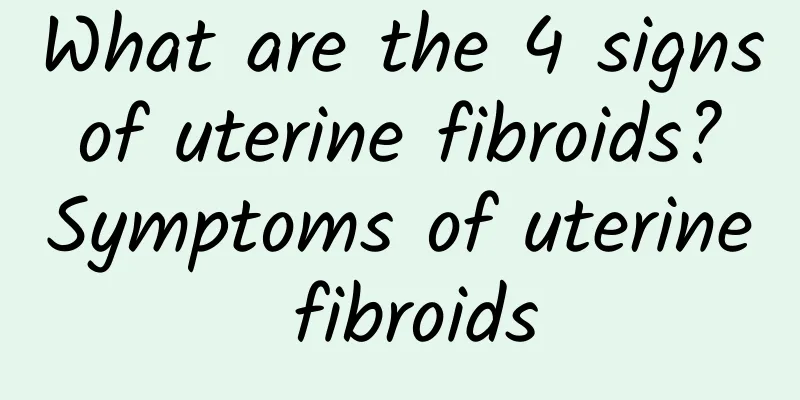What are the 4 signs of uterine fibroids? Symptoms of uterine fibroids

|
What are the 4 signs of uterine fibroids? Symptoms of uterine fibroids Uterine fibroids are a common tumor disease in women, mainly occurring in women of childbearing age. They are tumorous lesions formed by abnormal proliferation of uterine muscle cells. Although uterine fibroids do not necessarily cause symptoms, in some cases there are some obvious signs. This article will introduce the 4 signs of uterine fibroids and their symptoms. The first sign is abnormal menstruation. Uterine fibroids often lead to irregular menstruation, including symptoms such as prolonged menstruation, increased menstrual flow, and blood clots during menstruation. Some patients also experience increased menstrual pain. This is because the presence of uterine fibroids affects the normal shedding and recovery of the endometrium, leading to abnormal menstruation. The second sign is pelvic pain. Many patients experience pain in the lower abdomen or pelvic cavity when uterine fibroids occur. This pain can be continuous, dull, or paroxysmal. Some patients also experience back pain, perineum discomfort, and pelvic oppression. The third sign is frequent or urgent urination. Uterine fibroids are located in the appendages of the uterus, which are adjacent to the urinary system. When uterine fibroids grow and compress the urethra or bladder, patients may experience symptoms such as frequent urination, urgent urination, and weak urination. This is because the pressure of uterine fibroids affects the normal function of the urinary system. The fourth sign is compression of abdominal organs. If uterine fibroids grow to a certain size, they may cause compression of abdominal organs. This can cause patients to experience symptoms such as abdominal distension, indigestion, difficulty in defecation, abdominal pain, etc. Some patients may also feel a mass in the abdomen. Although uterine fibroids are common, many patients still do not know enough about them. Knowing the four signs of uterine fibroids can help patients detect them in time and seek medical treatment. However, these signs are not necessarily pathological signs of uterine fibroids and may also be related to other diseases. Therefore, if the above symptoms occur, it is recommended that women seek medical attention in time and undergo relevant examinations to clarify the cause. Knowing the 4 signs of uterine fibroids can help prevent and identify the disease. If women experience symptoms such as abnormal menstruation, pelvic pain, frequent and urgent urination, and compression of abdominal organs, they should seek medical attention in time. Early detection and treatment can help patients better manage uterine fibroids and avoid further complications. |
>>: Why do I only see uterine fibroids on one side? Why do uterine fibroids grow on the left side?
Recommend
What causes uterine cysts?
The causes of uterine cysts include genetics, env...
Get back quality sleep by supplementing 3 nutrients
(Author: Pan Huaizong, Sui Ande, Zhang Yafang, ET...
Does vaginal candidal infection have symptoms of excessive leucorrhea?
Abnormal leucorrhea is very dangerous, especially...
How long after abortion should I do color Doppler ultrasound examination? What vegetables are good to eat after abortion?
I believe that female friends are familiar with a...
What are the main causes of pelvic inflammatory disease?
Pelvic inflammatory disease is a common gynecolog...
Why do you get ovarian chocolate cysts?
What is ovarian chocolate cyst? At first glance a...
What is the cause of dysmenorrhea in women?
Dysmenorrhea is not unfamiliar to every woman who...
Improve metabolism and burn fat ~ These 3 fruits with yogurt will help you lose weight quickly
To lose weight, you don’t have to go on a diet or...
How to treat bilateral ovarian polycystic changes
The ovaries are one of the female organs unique t...
Is it normal for vaginal discharge to be a little light brown? It may be physiological
The change in the color of a woman's vaginal ...
How to get rid of obesity and "tuna belly"? Traditional Chinese Medicine: Drinking dehumidifying and fat-removing tea, 3 tips to effectively control body fat
Don’t want to face the weighing scale after the C...
What are the treatments for severe cervical erosion?
What are the treatments for severe cervical erosi...
Attention should be paid to the treatment of vaginal bleeding in patients after abortion
Patients often experience vaginal bleeding after ...
What are the precautions for patients with congenital absence of vagina?
What are the precautions for patients with congen...
Is cervicitis serious? What kind of treatment is needed to get better?
Cervicitis was once a mild stage, but it also nee...









